|
|
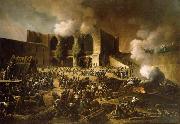 |
Francois Joseph Heim
|
|
(16 December 1787 - 29 September 1865) was a French painter.
He was born at Belfort. He early distinguished himself at the École Centrale of Strassburg, and in 1803 entered the studio of Vincent at Paris. In 1807 he obtained the first prize, and in 1812 his picture of "The Return of Jacob" (Musee de Bordeaux) won for him a gold medal of the first class, which he again obtained in 1817, when he exhibited, together with other works, a St John--bought by Vivant Denon.
In 1819 the "Resurrection of Lazarus" (Cathedral Autun), the "Martyrdom of St Cyr" (St Gervais), and two scenes from the life of Vespasian (ordered by the king) attracted attention. In 1823 the "Re-erection of the Royal Tombs at St Denis," the "Martyrdom of St Laurence" (Nôtre Dame) and several full-length portraits increased the painter's popularity; and in 1824, when he exhibited his great canvas, the "Massacre of the Jews" (Louvre), Heim was rewarded with the Legion of Honour.
In 1827 appeared the "King giving away Prizes at the Salon of 1824" (Louvre--engraved by Jazet) the picture by which Heim is best known and "Saint Hyacinthe." Heim was now commissioned to decorate the Gallery Charles X (Louvre). Though ridiculed by the romantists, Heim succeeded Regnault at the Institute in 1834, shortly after which he commenced a series of drawings of the celebrities of his day, which are of much interest.
His decorations of the Conference room of the Chamber of Deputies were completed in 1844; and in 1847 his works at the Salon "Champ de Mai" and "Reading a Play at the Theâtre Français" were the signal for violent criticisms. Yet something like a turn of opinion in his favour took place at the exhibition of 1851; his powers as draughtsman and the occasional merits of his composition were recognized, and toleration extended even to his colour.
Heim was awarded the great gold medal, and in 1855--having sent to the Salon no less than sixteen portraits, amongst which may be cited those of Cuvier, Geoffroy de St Hilaire, and Madame Hersent he was made officer of the legion of honour. In 1859 he again exhibited a curious collection of portraits, sixty-four members of the Institute arranged in groups of four.
Besides the paintings already mentioned, there is to be seen in Nôtre Dame de Lorette (Paris) a work executed on the spot; and the museum of Strassburg contains an excellent example of his easel pictures, the subject of which is a Shepherd Drinking from a Spring.
cjr |
|
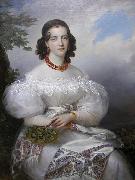 |
Francois Joseph Kinson
|
|
François-Joseph Kinson (1771-1839) was a Flemish painter.
Kinson attended art school at Bruges and soon established a reputation in Ghent and Brussels. He exhibited a portrait in Paris in 1799. Settling in Paris after the exhibition, the artist courted the favor of the rich and famous of the time. Kinson worked for Napoleones court and eventually became court painter to Jerôme Bonaparte, King of Westphalia. Kinson is best remembered for his portraits of elegant women. The artist worked as a court painter in Paris until 1830, and died in 1839 at the age of 68.
|
|
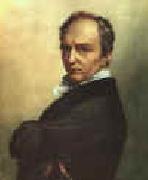 |
Francois Joseph Navez
|
|
1787-1869
French
Francois Joseph Navez gallery
Francois-Joseph Navez (Charleroi, 1787 - Brussels, 1869) was a Belgian neo-classical painter.
A pupil of Jacques-Louis David, he spent five years in Italy between 1817 and 1822.
He was a very successful portrait painter. He also painted many mythological and historic subjects.
The orientalist painter Jean-Francois Portaels was his pupil (and son-in-law). |
|
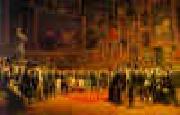 |
Francois-Joseph Heim
|
|
1787-1865
French Francois-Joseph Heim Gallery
He was born at Belfort. He early distinguished himself at the Ecole Centrale of Strassburg, and in 1803 entered the studio of Vincent at Paris. In 1807 he obtained the first prize, and in 1812 his picture of The Return of Jacob (Musee de Bordeaux) won for him a gold medal of the first class, which he again obtained in 1817, when he exhibited, together with other works, a St John-bought by Vivant Denon.
In 1819 the Resurrection of Lazarus (Cathedral Autun), the Martyrdom of St Cyr (St Gervais), and two scenes from the life of Vespasian (ordered by the king) attracted attention. In 1823 the Re-erection of the Royal Tombs at St Denis, the Martyrdom of St Laurence (Nôtre Dame) and several full-length portraits increased the painter popularity; and in 1824, when he exhibited his great canvas, the Massacre of the Jews (Louvre), Heim was rewarded with the Legion of Honour.
In 1827 appeared the King giving away Prizes at the Salon of 1824 (Louvre-engraved by Jazet) the picture by which Heim is best known and Saint Hyacinthe. Heim was now commissioned to decorate the Gallery Charles X (Louvre). Though ridiculed by the romantists, Heim succeeded Regnault at the Institute in 1834, shortly after which he commenced a series of drawings of the celebrities of his day, which are of much interest.
His decorations of the Conference room of the Chamber of Deputies were completed in 1844; and in 1847 his works at the Salon Champ de Mai and Reading a Play at the Theatre Francais were the signal for violent criticisms. Yet something like a turn of opinion in his favour took place at the exhibition of 1851; his powers as draughtsman and the occasional merits of his composition were recognized, and toleration extended even to his colour.
Heim was awarded the great gold medal, and in 1855-having sent to the Salon no less than sixteen portraits, amongst which may be cited those of Cuvier, Geoffroy de St Hilaire, and Madame Hersent he was made officer of the legion of honour. In 1859 he again exhibited a curious collection of portraits, sixty-four members of the Institute arranged in groups of four.
Besides the paintings already mentioned, there is to be seen in Notre Dame de Lorette (Paris) a work executed on the spot; and the museum of Strassburg contains an excellent example of his easel pictures, the subject of which is a Shepherd Drinking from a Spring. |
|
|
|
|
|
|
|
|
|
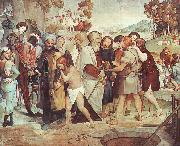 |
Friedrich Johann Overbeck
|
|
1789-1869
German
German religious painter. Expelled from the Vienna Academy because of his opposition to its classicism, he went to Rome and with Peter von Cornelius, Veit, Schadow-Godenhaus, and others, formed the group known as the Nazarenes. His first real successes were his frescoes for the Casa Bartholdy (now in Berlin) and for the Villa Massimo. Among his notable paintings are Christ Entry into Jerusalem and Christ Agony in the Garden. Overbeck sought to make his art serve religion. His influence was due more to the purity of his doctrine than to the power of his work, which is often lacking in pictorial appeal and in color. |
|
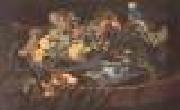 |
FYT, Jan
|
|
Flemish Baroque Era Painter, 1611-1661
Flemish painter, draughtsman and etcher. He was apprenticed in Antwerp in 1621-2 to Hans van den Berch [Berghe] (not to be confused with Jan van den Bergh of Alkmaar) and probably completed his training with Frans Snyders. In 1629-30 Fyt became a master in the Antwerp Guild of St Luke, but he continued to work for Snyders until 1631. In 1633 and 1634 he was in Paris. According to his biographers, he then went to Italy; an Italian journey is confirmed by the fact that in 1650 he joined the Antwerp Guild of Romanists (exclusive to those who had visited Rome), of which he became the dean in 1652. He apparently worked in Rome, where he joined the Schildersbent and was given the nickname 'Goudvink' (Dut.: 'goldfinch'). In Venice, according to Orlandi, Fyt worked for the Sagredo and Contarini families. He is also thought to have visited Naples, Florence and Genoa, and Orlandi stated that he also went to Spain and London. By 5 September 1641 Fyt was back in Antwerp, where, apart from a brief trip to the northern Netherlands in 1642, he apparently remained for the rest of his career.
|
|
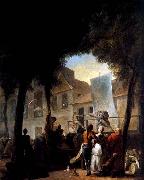 |
Gabriel Jacques de Saint-Aubin
|
|
French Painter, 1724-1780,Draughtsman, etcher and painter, brother of (1) Charles-Germain de Saint-Aubin. He studied with the painters Etienne Jeaurat and Hyacinthe Colin de Vermont, but failed three times to win the Prix de Rome (competition paintings, 1752-4; Paris, Louvre). He broke with the Academie Royale, preferring to support and exhibit at the Academie de St Luc. Although he continued to paint such pictures as a Street Show in Paris (c. 1760; London, N.G.; other examples in Rouen, Mus. B.-A.), he is best known as a draughtsman and etcher. He was a passionate and unconventional observer of the sights of the Paris streets and of the social scene. Dacier saw him as the 'man who drew at all times and in all places', and his contemporary Jean-Baptiste Greuze spoke of his 'priapism of draughtsmanship'. In his many drawings he combined pencil, black and red chalk, bistre, ink and watercolour to create dazzling spontaneous effects. He drew incidents that struck him as he wandered the streets, or entertainments that he attended. He recorded them, noting dates and times, in sketchbooks (e.g. Paris, Louvre and Stockholm, Nmus.) or sometimes in the margins and blank pages of printed books that he was carrying (such as a volume of the poems of Jean-Michel Sedaine, in the Mus. Cond?, Chantilly). These drawings of contemporary incidents include the Fire at the Foire Saint-Germain on the Night of 16-17 May 1762 (ex-David Weill priv. col.) and the Crowning of Voltaire at the Theetre-Franeais in 1778 (Paris, Louvre; see fig.). He went regularly to the Salon of the Academie Royale and to art sales, covering the margins and flyleaves of his sale catalogues and Salon livrets with tiny sketches of works of art and the passing scene. One hundred of these illustrated catalogues were among his effects when he died, and of these about a third survive. These include the livrets for the Salons of 1761, 1769 and 1777 (all Paris, Bib. N.), as well as the catalogues of the sales of Louis-Michel van Loo in 1772 and Charles Natoire in 1778 (both Paris, Bib. N.), and that of Pierre-Jean Mariette in 1775 (Boston, MA, Mus. F.A.). Together with his etchings and large watercolours (e.g. Paris, Louvre) of the Louvre's Salon Carre at the time of the exhibitions of 1753, 1767 and 1769, |
|
|
|
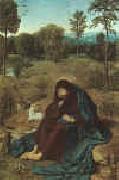 |
Geertgen Tot Sint Jans
|
|
Netherlandish Northern Renaissance Painter, ca.1460-1490
Geertgen tot Sint Jans is also known as Geertgen van Haarlem, Gerrit van Haarlem, or Gerrit Gerritsz.[citation needed] Alternative spellings of his first name are Gheertgen, Geerrit, and Gheerrit, where G(h)eertgen is the diminutive form of G(h)eerrit.
Presumably, he was born in Leiden, then in the Burgundian Netherlands in the Holy Roman Empire, around the year 1465. The assignment of Leiden as his birth place is traceable to a 17th century print by Jacob van Matham. There is no known archival evidence for this claim by Jacob van Matham. The modern acceptance of Leiden as Geertgen's birth place is roughly traceable to Johann Kessler's dissertation of 1930.
Probably, Geertgen was a pupil of Albert van Ouwater, who was one of the first oil painters in the northern Low Countries. Both painters lived in the city of Haarlem. Geertgen was attached to the monastery of the Knights of Saint John, for whom he painted an altarpiece. Although Geertgen was not a member of the Order of Saint John, his last name "tot Sint Jans" was derived from the order's name and means "unto Saint John".
Geertgen died in Haarlem, then the Habsburg Netherlands in the Holy Roman Empire, around the year 1495, when he was approximately 28 years old. He was buried in the monastery of the Knights of Saint John. Modern scholars have attempted to calculate the artist's death date with the information from The Painting-Book (Middle Dutch: Het Schilder-Boeck) by Karel van Mander, published in 1604. There are some archival traces that suggest he may in fact have lived into the 16th century. |
|
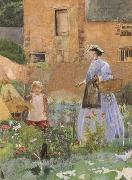 |
George John Pinwell,RWS
|
|
1842-1875
English illustrator and painter. He was born in humble circumstances and was largely untrained. He was briefly a student at St Martin's Lane Art School and at Heatherley's. From 1863 he contributed woodblock illustrations to magazines, establishing his reputation in 1865 with the Dalziel brothers' editions of The Arabian Nights and The Works of Oliver Goldsmith. Pinwell's finest drawings were commissioned for the Dalziels' poetry gift-books. With another illustrator, John William North (1842-1924), he worked at Halsway Manor in Somerset in 1865, experimenting with formal effects based on the structure of stone farm buildings or on the wooden beams of barn interiors (his drawings do not seem to have survived). Some of the illustrations for A Round of Days (1866) and Wayside Posies (1867) present an ideal vision of the countryside, but a vein of social concern is also present. In The Journey's End, from Wayside Posies, a strolling player lies dead, worn out by hardship and hunger. For an illustrated edition of Jean Ingelow's Poems (1867), |
|
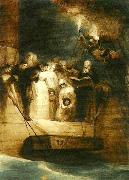 |
george jones
|
|
George Glenn Jones (born September 12, 1931) is an American country music singer known for his long list of hit records, his distinctive voice and phrasing, and his marriage to Tammy Wynette.
Over the past 20 years, Jones has frequently been referred to as "the greatest living country singer." Country music scholar Bill C. Malone writes, "For the two or three minutes consumed by a song, Jones immerses himself so completely in its lyrics, and in the mood it conveys, that the listener can scarcely avoid becoming similarly involved."
Throughout his long career, Jones made headlines often as much for tales of his drinking, stormy relationships with women, and violent rages as for his prolific career of making records and touring. His wild lifestyle led to Jones missing many performances, earning him the nickname "No Show Jones." With the help of his fourth wife, Nancy, he has been sober for many years. Jones has had more than 150 hits during his career, both as a solo artist and in duets with other artists. The shape of his nose and facial features have given Jones the nickname "The Possum." Jones said in an interview that he has chosen to tour only about 60 dates a year. |
|
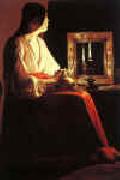 |
Georges de La Tour
|
|
1593-1652
French
Georges de La Tour Galleries
His early work shows influences from Caravaggio, probably via his Dutch followers, and the genre scenes of cheats??as in The Fortune Teller ??and fighting beggars clearly derive from the Dutch Caravaggisti, and probably also his fellow-Lorrainer, Jacques Bellange. These are believed to date from relatively early in his career.
La Tour is best known for the nocturnal light effects which he developed much further than his artistic predecessors had done, and transferred their use in the genre subjects in the paintings of the Dutch Caravaggisti to religious painting in his. Unlike Caravaggio his religious paintings lack dramatic effects. He painted these in a second phase of his style, perhaps beginning in the 1640s, using chiaroscuro, careful geometrical compositions, and very simplified painting of forms. His work moves during his career towards greater simplicity and stillness ?? taking from Caravaggio very different qualities than Jusepe de Ribera and his Tenebrist followers did.
He often painted several variations on the same subjects, and his surviving output is relatively small. His son Etienne was his pupil, and distinguishing between their work in versions of La Tour's compositions is difficult. The version of the Education of the Virgin, in the Frick Collection in New York is an example, as the Museum itself admits. Another group of paintings (example left), of great skill but claimed to be different in style to those of de La Tour, have been attributed to an unknown "Hurdy-gurdy Master". All show older male figures (one group in Malibu includes a female), mostly solitary, either beggars or saints.
After his death in 1652, La Tour's work was largely forgotten until rediscovered by Hermann Voss, a German scholar, in 1915. In 1935 an exhibition in Paris began the revival in interest among a wider public. In the twentieth century a number of his works were identified once more, and forgers tried to help meet the new demand; many aspects of his œuvre remain controversial among art historians. |
|
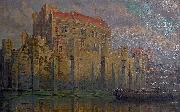 |
Georges Jansoone
|
|
George Jamesone (or Jameson) (c. 1587-1644) was Scotland's first eminent portrait-painter.
He was born in Aberdeen, where his father, Andrew Jamesone, was a stonemason. Jamesone attended the grammar school near his home on Schoolhill and is thought to have gone on to further education at Marischal College. Legend has it that Jamesone once studied under Rubens in Antwerp with Anthony van Dyck. However, this is yet to be proven as his name does not appear to be noted in the Guild registers of the town. However, considering that Rubens was exempt from registering pupils; this does not mean that the painter definitely did not study there. Jamesone certainly did complete an apprenticeship under the supervision of his uncle, John Anderson, who was a popular decorative painter in Edinburgh at the beginning of the seventeenth century. Jamesone finished this training in 1618. He is not recorded as being in Aberdeen again until 1620. If the Scotsman had gone to Antwerp, it would have had to have been between the years of 1618 to 1620. |
|
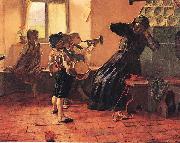 |
Georgios Jakobides
|
|
Lesbos 11 January 1853 - Athens 13 December 1932) was a Greek painter and one of the main representatives of the Greek artistic movement of the Munich School. He founded and was the first curator of the National Gallery of Greece in Athens.
His first education was in Izmir, Turkey. From 1870 to 1876 Jakobides studied sculpture and painting at the Athens School of Fine Arts, and in 1877 he went to the Akademie der Bildenden Kenste in Munich on a scholarship to continue his painting studies under Karl Theodor von Piloty. In Munich he lived for 17 years where he worked in his studio, painting mythological scenes, genre pictures, and portraits. His work is influenced by German academic Realism, his most famous paintings were of children. In the capital of Bavaria he was regarded as a successful German artist selling many of his works at high prices. The Greek government invited him in 1900 to return to Athens to organize the National Gallery of Athens, and in 1904 he was appointed Director of the Athens School of Fine Arts where he taught for 25 years. At this time, additional to his themes he produced formal portraits of eminent Greeks (e.g.Queen Sophia). He opposed all new artistic tendencies, including Impressionism and Expressionism, but supported younger artists to follow their own individual artistic tendencies.
He was given awards at five international exhibhits: among those in Berlin 1891 and in Paris 1900. |
|
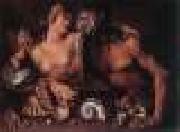 |
GHEYN, Jacob de II
|
|
Dutch engraver/painter (b. 1565, Antwerp, d. 1629, The Hague).
was a Dutch painter and engraver, whose work shows the transition from Northern Mannerism to Dutch realism over the course of his career. De Gheyn received his first training from his father, Jacob de Gheyn I, a glass painter, engraver, and draftsman. In 1585, he moved to Haarlem, and studied under Hendrik Goltzius for the next five years. He moved again to Leiden in the middle of the 1590s. His first commission was for an engraving of the Siege of Geertruitenberg from Amsterdam city officials in 1593. Around 1600, de Gheyn abandoned engraving, and focused his work on painting and etching. Moving to The Hague in 1605, he was employed often by Dutch royalty, designing a garden in the Buitenhof for Prince Maurice of Orange which featured the two first grottoes in the Netherlands. After Prince Maurice's death in 1625, de Gheyn worked for Prince Frederick Henry, his brother. De Gheyn painted some of the earliest female nudes, vanitas, and floral still lifes in Dutch art. He is credited with creating over 1,500 drawings, including landscapes and natural history illustrations. |
|
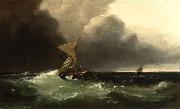 |
Gideon Jacques Denny
|
|
(1830-1886) was a marine artist who was born in Wilmington, Delaware on July 15, 1830. As a young man, he worked on ships in the Chesapeake Bay. He traveled to California in 1849 with the Gold Rush. He worked as a teamster on the San Francisco docks and was a member of the San Francisco Committee of Vigilance. After two years in California, he moved to Milwaukee, where he studied painting with Samuel Marsden Brookes. After six years of study in Milwaukee, Denny returned to San Francisco and established a studio on Bush Street. In 1862, Brooks moved to San Francisco and shared a studio with Denny. In 1868, Denny spent two months in Hawaii visiting several islands. He is also known to have visited Canada and South America. Denny died of malaria in Cambria, California on Oct. 7, 1886.
The Berkeley Art Museum and Pacific Film Archive, the Bishop Museum (Honolulu), the Crocker Art Museum (Sacramento, California), the Fine Arts Museums of San Francisco, Monterey Peninsula Museum of Art, and the Oakland Museum of California are among the public collections holding works by Gideon Jacques Denny.
|
|
|
|
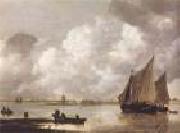 |
GOYEN, Jan van
|
|
Dutch Baroque Era Painter, 1596-1656
Jan van Goyen was born in Leiden on Jan. 13, 1596. Apprenticed from the age of 10, he had several masters. About 1617 he went to Haarlem to study with Esaias van de Velde, an important innovator in the Haarlem movement of realistic landscape painting. Van Goyen's works between 1621 and 1625 are sometimes hard to distinguish from those of his teacher. They are colorful, detailed views of villages and roads, usually busy with people, as in Winter (1621). It was Van Goyen's usual practice to sign or monogram and date his paintings. He traveled extensively through the Netherlands and beyond, recording his impressions in sketchbooks, occasionally with dates and often depicting recognizable scenes. Thus the chronology of his development is clear. His paintings of the late 1620s show a steady advance from the strong colors and scattered organization of his early works toward tonality and greater simplicity and unity of composition. By 1630 he was painting monochromes in golden brown or pale green; he played a leading part in the tonal phase of Dutch landscape painting. In 1631 Van Goyen settled in The Hague, where he became a citizen in 1634. The simplicity, airiness, and unification of his compositions continued to increase in his abundant production of dune landscapes, river views, seascapes, town views, and winter landscapes. The River View (1636) displays a river so open and extensive as to suggest the sea, with reflections that prolong the vast and luminous sky. In its monumentalization of humble structures and its composition built on a firm scaffolding of horizontal and vertical forces, it forecast at this early date developments that dominated landscape painting in the 1650s and later. In the Village and Dunes (1647) the traditional double-diagonal composition still exists, but it is dominated by horizontal and vertical accents. Stronger contrasts of light and dark replace the earlier tonality. In the last year of his life Van Goyen produced an eloquent new style, in which powerful forms stand out against the radiant sky and water in an exquisitely balanced composition (Evening Calm; 1656). The commission in 1651 to paint a panoramic view of The Hague for the Burgomaster's Room shows the high regard in which Van Goyen was held. He was enormously productive; well over 1,000 of his paintings still exist, and almost as many drawings. Yet he died insolvent, perhaps because of losses in his various business ventures, and soon after his death on April 27, 1656, |
|
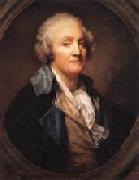 |
GREUZE, Jean-Baptiste
|
|
French Rococo Era Painter, 1725-1805
French painter and draughtsman. He was named an associate member of the Academie Royale de Peinture et de Sculpture, Paris, in 1755 on the strength of a group of paintings that included genre scenes, portraits and studies of expressive heads . These remained the essential subjects of his art for the next 50 years, except for a brief, concentrated and unsuccessful experiment with history painting in the late 1760s, which was to affect his later genre painting deeply. Though his art has often been compared with that of Jean-Simeon Chardin in particular and interpreted within the context of NEO-CLASSICISM in general, it stands so strikingly apart from the currents of its time that Greuze's accomplishments are best described, as they often were by the artist's contemporaries, as unique. He was greatly admired by connoisseurs, critics and the general public throughout most of his life. His pictures were in the collections of such noted connoisseurs as Ange-Laurent de La Live de Jully, Claude-Henri Watelet and Etienne-Francois, Duc de Choiseul. For a long period he was in particular favour with the critic Denis Diderot, who wrote about him in the Salon reviews that he published in Melchior Grimm's privately circulated Correspondance litt?raire. His reputation declined towards the end of his life and through the early part of the 19th century, to be revived after 1850, when 18th-century painting returned to favour, by such critics as Theophile Thore, Ars?ne Houssaye and, most notably, Edmond and Jules de Goncourt in their book L'Art du dix-huitieme siecle. By the end of the century Greuze's work, especially his many variations on the Head of a Girl, fetched record prices, and his Broken Pitcher (Paris, Louvre) was one of the most popular paintings in the Louvre. The advent of modernism in the early decades of the 20th century totally obliterated Greuze's reputation. |
|
|
|
|
|
|
|
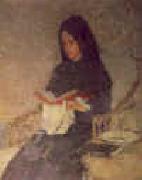 |
Gwen John
|
|
Welsh
1876-1939
Gwen John was born in Haverfordwest, Wales, the second of four children of Edwin William John and his wife Augusta (nee Smith). Edwin John was a solicitor whose dour temperament cast a chill over his family, and Augusta was often absent from the children due to ill health, leaving her two sisters??stern Salvationists??to take her place in the household. Despite the considerable tension in the family (who became known as "those turbulent Johns") the children's interest in literature and art was encouraged. Following the mother??s premature death in 1884, the family moved to Tenby in Pembrokeshire, Wales.
Although she painted and drew from an early age, her earliest surviving work dates from her nineteenth year. From 1895?C98, she studied at the Slade School of Art, where her younger brother, Augustus John, had begun his studies in 1894. During this period they shared living quarters, and further reduced their expenses by subsisting on a diet of nuts and fruit. Even as a student, Augustus' brilliant draughtsmanship and personal glamour made him a celebrity, and stood in contrast to Gwen's quieter gifts and reticent demeanour. While he greatly admired her art, Augustus offered her advice which she ignored; he urged her to take a "more athletic attitude to life", and cautioned her against what he saw as the "unbecoming and unhygienic negligence" of her mode of living, but her entire life was marked by a disregard for her physical well-being. In 1898 she made her first visit to Paris with two friends from the Slade, and while there she studied under James McNeill Whistler at the Academie Carmen. She returned to London in 1899, and spent the next four years in austere circumstances. When she exhibited her work for the first time in 1900, at the New English Art Club (NEAC), her address was a derelict building where she was living illegally. |
|
|
|
 |
Haberle John
|
|
American Painter, 1856-1933
was a 19th century American painter in the trompe l'oeil (literally, "fool the eye") style. His still lifes of ordinary objects are painted in such a way that the painting can be mistaken for the objects themselves. He is considered one of the three major figures??together with William Harnett and John F. Peto??practicing this form of still life painting in the United States in the last quarter of the 19th century. A Bachelor's Drawer by John Haberle, 1890?C94, oil on canvas, 50.8 x 91.4 cm, Metropolitan Museum of Art, New YorkHaberle was born in New Haven, Connecticut; his parents were Swiss immigrants. At the age of 14 he left school to apprentice with an engraver. He also worked for many years as an exhibit preparator for the Peabody Museum of Natural History at Yale University. His career as a painter began in 1887. His style is characterized by a meticulous rendering of two-dimensional objects. He is especially noted for his depictions of paper objects, including currency. Art historian Alfred Frankenstein has contrasted Haberle's work with that of his contemporaries: Peto is moved by the pathos of used-up things. Haberle is wry and wacky, full of bravado, self-congratulating virtuosity, and sly flamboyance. He works largely within an old tradition, that of the trompe l'oeil still life in painted line ... It is poles away from Harnett's sumptuosity, careful balances, and well-modeled volumes, and is equally far from Peto's sensitivity in matters of tone and hue. |
|
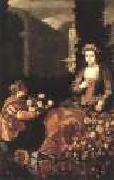 |
HAMEN, Juan van der
|
|
Spanish painter (b. 1596, Madrid, d. 1631, Madrid).
was a Spanish painter, a master of the still life paintings, also called bodegones. During his lifetime, he was prolific and versatile, painting allegories, landscapes, and large-scale works for churches and convents. However, today he is remembered mostly for his still lifes. In the 1620s, He popularized still life painting in Madrid. Juan van der Hamen y Leon was baptized on 8 April 1596 in Madrid, therefore, he must have been born there just days before that date. He was the son of Jehan van der Hamen, a Flemish courtier, who had moved to Madrid from Brussels before 1586, and Dorotea Whitman Gemez de Leon, a half-Flemish mother of noble Toledan ancestry . Van der Hamen and his two brothers Pedro and Lorenzo (both of whom were writers) emphasized their Spanish roots by using all or part of their maternal grandmother's family name, Gemez de Leon. The painter's father, Jan van der Hamen, had come to Spain, as an archer, to the court of Philip II were he settled, married, and his children were born. According to 18th-century sources, the artist's father had also been a painter, but there is no evidence for this. Juan van der Hamen inherited his father's honorary positions at court and also served as unsalaried painter of the king. Van der Hamen's artistic activity in the service of the crown is first recorded on 10 September 1619, when he was paid for painting a still-life for the country palace of El Pardo, to the north of Madrid. Noted for his versatility, Juan van der Hamen painted religious history paintings; allegories, landscapes, low-life subjects, portraits and still-lifes but the last two categories brought him the greatest fame. He served at the courts of Philip III and Philip IV and established the popularity of the new genre of still-life in Madrid in the 1620s. A prolific artist, van der Hamen painted all his works during the first decade of the reign of Philip IV. It is known that he painted more still lifes in 1622 than in any other period of his life. He also reached great personal fame as a portraitist, being this field, the one that provided him with greater personal success, since still life was considered a lesser genre. He executed a portrait of Philip IV and worked during the 1620s in a series of portraits of the principal intellectuals and writers of his time, including: Lope de Vega, Francisco de Quevedo, Luis de Gengora, Jose de Valdivieso, Juan Perez de Montalbon, Juan Ruiz de Alarcen and Francisco de Rioja. On van der Hamen's death, twenty of these portraits were inventoried as a single item among his belongings. The portrait of his older brother, Lorenzo van der Hamen, probably belonged to this series. The series itself was a focal point for philosophic speculation on the art of portraiture by some of the most distinguished minds of the time, who frequently praised Juan van der Hamen in verse and prose. Among Van der Hamen portraits, there is one of a dwarf, painted around 1623 in a powerful naturalistic style. This painting (Madrid, Museo del Prado) anticipated the later made by Velezquez. In 1626, van der Hamen painted cardinal Francesco Barberini, after a previous portrait by Velezquez had failed to please the sitter. Well satisfied with his work Cardinal Barberini acquired three further works from him. As a religious painter Juan van der Hamen worked for several religious institutions in and around Madrid and Toledo, like the Monastery of the Descalzas Reales, in Madrid, for which he painted altars. Few of these paintings are extant. The best surviving examples of his religious work are in the cloister of the Royal Convent of La Encarnacion in Madrid, painted in 1625 in a naturalistic tenebristic style. Juan van der Hamen was also a pioneer in the field of flower painting. Van der Hamen probably began painting floral arrangements in response to the flower pieces of Flemish artists, such as Jan Brueghel, who were regarded as exemplary masters in the field and whose works were much sought after in Spain. One good example of his work as a flower painter is his Offering to Flora , a visual poem that parallels the lyric verse of his time, in which he united his skills as portraitist and flower painter to produce one of the most beautiful paintings of the allegory of spring. |
|
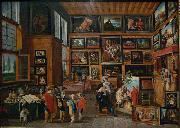 |
Hans Jordaens
|
|
(1555 - 1630), was a Flemish Baroque painter whose religious works are often confused with that of other painters with the same name.
|
|
 |
Hans Jorgen Hammer
|
|
(29 December 1815, Copenhagen - 28 Januar 1882, Rome) was a Danish artist who specialized in genre painting.
Following an apprenticeship with J.G. Berg in Copenhagen, Hammer was admitted to the Danish Academy in 1828. In 1841, he became a student of Christoffer Wilhelm Eckersberg who remained a close friend. He was awarded the Academy's little silver medal in 1842 and the large silver medal the following year. Det sidste Læs, his entry for the Neuhausen Prize in 1845, was bought by Statens Museum for Kunst but it was not until 1837 that he was awarded the prize with Bønder forsamlede til Lystighed en Søndag Eftermiddag under aaben Himmel.
Hammer was an industrious but rather serious and thoughtful artist. His avid approach to detail slowed down his work considerably. After the outbreak of war in 1848, he became a naval officer. With a stipendium from the Academy, he travelled to Italy in 1857 where he painted Torvet i Ariccia efter Solnedgang, considerably enhancing his reputation in Denmark. The painting was acquired by Statens Museum for Kunst in 1863. Other notable works are Axsamlersken (1866) and Postbudet med det længe ventede Brev (1877). After recovering from a serious illness, he travelled to Rome in 1881 but died there the following year
|
|
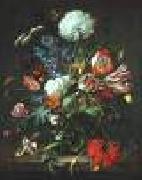 |
HEEM, Jan Davidsz. de
|
|
Dutch painter (b. 1606, Utrecht, d. 1684, Antwerpen).
Dutch painter of fruit and flower pieces. He studied with his father, David de Heem, and became one of Holland's foremost still-life painters. His paintings are found in many leading European museums; the Metropolitan Museum possesses three examples. His son and pupil, Cornelis de Heem, c.1631 C 1695, |
|
|
|
|
|
|
|
|
|
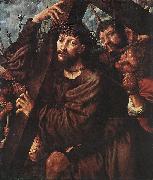 |
HEMESSEN, Jan Sanders van
|
|
Netherlandish Mannerist Painter, ca.1500-1566
was a Flemish Northern Renaissance painter. He was born in Hemiksem, then called Hemessen or Heymissen. Following studies in Italy, in 1524 he settled in Antwerp. A mannerist, his images focused on human failings such as greed and vanity. Like his daughter, Catarina van Hemessen, he also painted portraits. Jan Sanders van Hemessen was a Flemish Northern Renaissance painter. Jan Sanders van Hemessen was from Netherlands. The type of movement he did was mannerism Jan Sanders was born in Hemessen but settled in Antwerp in 1524 after studying in Italy. Hemessen specialized in scenes of human character flaws such as vanity and greed. His pictures are also normally religious and his style helped found the Flemish traditions of genre painting. Hemessen was also a portrait painter, which influenced his daughter to become a Flemish Northern Renaissance painter as well. The Surgeon was painted by Jan Sanders Van Hemessen, in 1555. The oil painting is in a museum called Museo Del Prado, which is in Madrid, Spain. I think the scene painted by Jan Sanders van Hemessen shows a stone cutter at a fair. The surgeon, who is clearly happy that his operations have been successful, painstakingly moves his knife towards the stone, which is already visible. Behind him hang stones which have been successfully cut out of the head of other patients as a sign of his skill. |
|
|
|
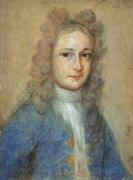 |
Henrietta Johnston
|
|
b.born before 1670, probably Ireland buried March 7, 1729,
was an early American pastellist. Born Henrietta Deering, probably in Ireland, she married in 1705 and emigrated to America in 1707, settling in Charles Towne (now Charleston, South Carolina). A total of 40 pastel portraits by Johnston are known, dating from 1707 to around 1725. After her husband's death in 1716, Johnston was forced to support herself and her children, becoming possibly the first professional female painter in America. She's a very talented artist. |
|
 |
Henry de Groux
|
|
Belgian
1867-1930
Henry de Groux (1866 in Brussels - 1930 in Marseilles) was a Belgian Symbolist painter, sculptor and lithographer. His 1889 painting Christ aux Outrages, widely described as his masterwork, depicted Jesus being attacked by a mob. Later in life, he produced many works depicting the horrors of the First World War.
Ride of the Valkyries (ca. 1890)
Royal Museums of Fine Arts, Brussels, BelgiumDe Groux was a member of les XX, but was expelled when he refused to have his works displayed in the same gallery as Vincent van Gogh. He subsequently moved to Paris, where he befriended Emile Zola; during the social unrest resulting from the Dreyfus affair, de Groux acted as one of Zola's bodyguards.
As well, de Groux was a fervent diarist; beginning in 1892, he produced 18 volumes detailing the life of a European artist in the late 19th and early 20th centuries. In 2002, his descendants donated these volumes to the Institut national d'histoire de l'art; selected excerpts were published in 2007 Henry de Groux 1866-1930 - journal - Henry De Groux, Rodolphe Rapetti, Pierre Wat - Editions Kime. |
|
|
|
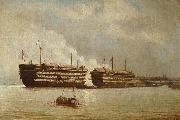 |
Henry J. Morgan
|
|
painted HMS 'Excellent' and HMS 'Illustrious' by Henry J. Morgan in 1860s |
|
|
|
|
|
|
|
|
|
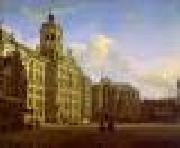 |
HEYDEN, Jan van der
|
|
Dutch Baroque Era Painter, 1637-1712
Dutch painter, draughtsman, printmaker and inventor. In 1650 he moved to Amsterdam with his family; his father, a Mennonite, who had pursued various occupations rather unsuccessfully, died that year. Jan's artistic training may have begun with drawing lessons in the studio of a relative, perhaps his eldest brother, Goris van der Heyden, who made and sold mirrors; Jan may also have studied the reverse technique of glass painting with an artist in Gorinchem. Painting occupied relatively little of his time, however, although he continued to pursue it throughout his long life. His prosperity was mainly due to his work as an inventor, engineer and municipal official. He designed and implemented a comprehensive street-lighting scheme for Amsterdam, which lasted from 1669 until 1840 and was adopted as a model by many other towns in the Netherlands and abroad. In 1672, |
|
|
|
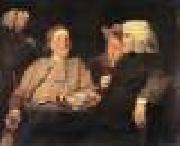 |
HIGHMORE, Joseph
|
|
English Painter, 1692-1780
English painter and writer. The son of a coal merchant and the nephew of Thomas Highmore (1660-1720), Serjeant-Painter to the King, he was articled to an attorney on 18 July 1707. Bored with his duties, he attended Kneller's Academy from 1713 and in 1715 abandoned law, setting up as a portrait painter in the City of London. From 1720 he attended the St Martin's Lane Academy, where he was able to study contemporary French styles in art and design, particularly that of Gravelot. He read widely and mastered Brook Taylor's system of perspective (1715). He also attended William Cheselden's anatomy lectures and contributed designs to that author's Anatomy of the Human Body (1722). |
|
|

